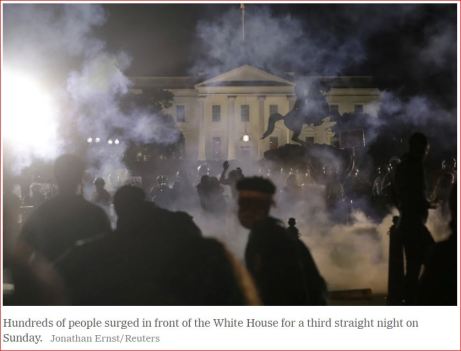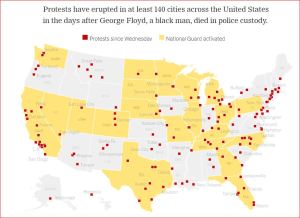.
PNAS peer reviewed study: Sahara Dust travels across the Atlantic Ocean, the state of Florida, and the Gulf of Mexico, 5/9/2016…“It has been happening for thousands of years.“…“Millions of tonnes of mineral dust are blown from the Sahara desert to the Amazon basin each year. The dust helps keep the Brazilian rainforest soils fertile."…”Scientists found dust from the Sahara influences levels of precipitation as far as California.”
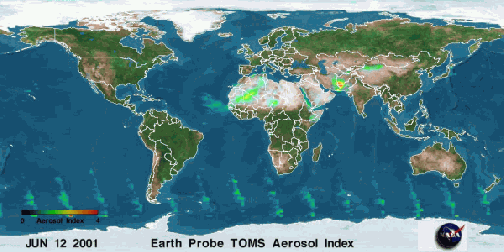
Image caption: Satellites can track African dust clouds as they migrate across the Atlantic Ocean. This NASA TOMS aerosol movie, which spans the interval June 13 through 21, 2001, shows such a cloud raining bits of the Sahara Desert over the Caribbean and the Gulf of Mexico. [more information] NASA tested 8,100 sq. mile region between Tampa Bay and Fort Myers, Florida-Aug. 2001 study
8/30/2001, “Desert Dust Kills Florida Fish,” “New research links huge African dust clouds with the “red tides” that kill millions of fish along the Florida coast each year," science.nasa.gov
“Without warning, the sea turns a shade of reddish brown, killing scores of fish and other marine life — and making the water an unwelcome place for humans.
Such “red tides” have, from time to time, plagued coastal communities for centuries. Now a new study, partially funded by NASA, has revealed a surprising connection between red tides in the Gulf of Mexico and giant dust clouds that blow across the Atlantic Ocean from the distant Sahara Desert. NOAA and NASA satellites can spot such dust clouds en route from Africa to the Americas, raising hopes that space-based data could help scientists predict when red tides will strike the Gulf coast….
“The West Florida shelf is a hot spot for fishing, aquaculture and tourism, all of which can be drastically affected by a surprise visit from a red tide,”
said Jason Lenes, a graduate student at University of South Florida’s
College of Marine Science, and the lead author in the study.
Red tides, which are actually blooms of toxic algae, have in the past killed huge numbers of fish, shellfish, marine mammals, and birds. They can also trigger skin and respiratory problems in humans.
The addition of biologically usable nitrogen in the water makes the Gulf of Mexico a friendlier environment for toxic algae. “This is one of the first studies that quantitatively measured iron from the dust and [linked] it to red tides through Trichodesmium,” said Lenes.The research was partially funded by a NASA grant as part of ECOHAB: Florida (Ecology and Oceanography of Harmful Algal Blooms), a multi-disciplinary research project designed to study harmful algae.
The study used satellite and ground based measurements to track large dust clouds leaving Africa on June 17, 1999. Lenes and his colleagues followed the clouds using data from the Advanced Very-High-Resolution Radiometer (AVHRR), an imager aboard the NOAA’s Polar Orbiting Environmental Satellites (POES).
The Saharan dust reached the West Florida shelf around July 1st, increasing iron concentrations in the surface waters by 300 percent. As a result, Trichodesmium counts
shot up to 10 times what they had been prior to this event. Through a
complex process involving a special enzyme called nitrogenase, the Trichodesmium used the iron to convert nitrogen in the water to a form more usable for other marine life.
In October, after a 300 percent increase of this biologically-accessible nitrogen, a huge bloom of toxic red algae (Karenia brevis) had formed within the study area, an 8,100 square mile region between Tampa Bay and Fort Myers, Florida….
Scientists have labored for several years to develop a reliable method to predict red tides, particularly because the results of these blooms can be both physically and economically devastating to a region.
..
Humans who swim in the Gulf during a red tide can experience respiratory problems by breathing toxins from K. brevis that get in the air. Also, eating shellfish poisoned by red tides can lead to paralysis and memory problems. Around the Gulf of Mexico, scientists and others have recorded fish kills totaling in the millions and manatee deaths in the hundreds resulting from a single red tide bloom.
By using satellites to monitor dust arrivals and Trichodesmium blooms, Lenes said this research could lead to forecasting of red tides. “If you could predict when a red tide is coming, you could close beaches and fisheries ahead of time,” Lenes said.
Note: The research reported here appears in the September [2001] issue issue of the scientific journal Limnology and Oceanography. The paper was funded through a number of grants connected with the ECOHAB program. Other funding for this study included grants from the National Oceanic and Atmospheric Administration, the Office of Naval Research and the Environmental Protection Agency. The ECOHAB: Florida Mission is to better understand the factors involved in the occurrence and dispersal of Florida’s predominant red tide algae, K. brevis, and to predict and manage harmful algal bloom events.”
……………………
Added: PNAS peer reviewed study: Sahara Dust travels across the Atlantic Ocean, across the state of Florida, across the Gulf of Mexico,” 5/9/2016
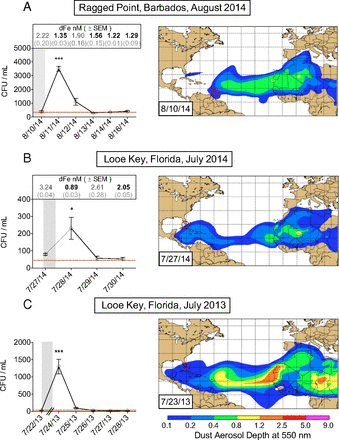
May 9, 2016, “Saharan dust nutrients promote Vibrio bloom formation in marine surface waters," PNAS.org https://doi.org/10.1073/pnas.1518080113
………………………
Added: Washington Post: How dust from the Sahara fuels poisonous bacteria blooms in the Caribbean,” Washington Post, Sarah Kaplan, May 11, 2016
“Leave your car parked outside in Miami for too many days in August, and you’re likely to see a fine film of orange powder coating the windshield.
It’s dust — African dust — carried thousands of miles across the Atlantic to parking lots in Florida.
This phenomenon, known as the Saharan Air Layer, brings several hundred million tons of dust to the Americas each year. It helps build beaches in the Caribbean and carries nutrients that fertilize the Amazon rainforest. The dust is also thought to help suppress hurricanes along the coast.
“It has been happening for thousands of years, but
in the past few decades, scientists have become concerned about the
effects of this dust on coral reef ecosystems in the Caribbean. Studies
have linked the dust plumes to toxic “red tides” — huge algae blooms that poison fish and trigger skin and breathing problems in people. There’s also some evidence suggesting that African microbes may be hitching rides on the dust and poisoning corals on the other side of the sea.
But what about the bacteria that already live in the ocean? In a study published this week in the Proceedings of the National Academy of Sciences, scientists examined how one genus of bacteria, a pathogen called Vibrio, responded to the influx of dust that rains down on the Caribbean in the late summer months.”…
………………………….
Added: “Scientists found dust from the Sahara influences levels of precipitation as far as California:” “Saharan dust: Six things you didn’t know about red dust storms,” Independent UK, Heather Saul, 4/2/2014
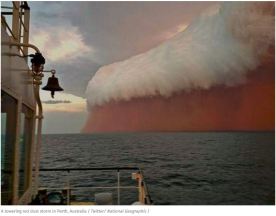
“Dust all the way from Africa has reached Britain after unusual weather patterns”
“Motorists across the country awoke to grains of dust coating their cars on Monday, which had travelled all the way from the Saharan desert to leave a little piece of North Africa on their vehicles.
But the dust has also triggered fears it may cause health problems for people across Britain. The Government issued warnings of “very high” levels of air pollution across parts of England and Wales, after the dust and winds combined to create a potentially toxic storm.
Here are six other things you may not have known about Saharan dust:
1. Red dust storms can cause air pollution to increase
to “very high levels” and can aggravate breathing problems. Health
professionals warn the dust may irritate lung tubes and cause asthma to
flare up.
2. While it may not be healthy for humans, Saharan dust can prove beneficial for the environment. Trees and plants in the Amazon Rainforest rely on the nutrient-rich dust, which helps to keep the area fertile, New Scientist reported.
3. However,
researchers have also linked Saharan dust to coral disease. Coral reefs
in the Caribbean have been in a state of decline since the 1970s. Scientists from the US Geological Survey (USGS) Centre for Coastal Geology believe this decline in the Caribbean is a result of pathogens transported in dust from North Africa.
4. The dust clouds can literally turn the sea from blue to a reddish brown by encouraging the growth of algae blooms in a phenomenon known as red tides.The toxic blooms have been responsible for the deaths of huge numbers of fish, marine mammals and birds in the past. They can also have an impact on human health by causing respiratory problems for those living near a shoreline.
5. Dust clouds from the Sahara are often so big they can be seen from space. Space station crew members frequently report seeing Saharan dust masses as very widespread atmospheric haze, according to NASA.
6. These dust palls blowing from Africa can be lifted as high as 15,000 feet and transported across the Atlantic Ocean. Scientists found dust from the Sahara influences levels of precipitation as far as California because of a hot, dry, dusty layer of air known as the Saharan Air Layer.” (image above: “A towering red dust storm in Perth, Australia (Twitter/ National Geographic )“)
………………………..
Added: How African dust travels to UK: “Deadly smog leaves us gasping for breath: Millions of asthmatics struggle as giant cloud of Saharan sand and toxic air covers Britain,“ UK Daily Mail, Ben Spicer, 4/2/2014

“Journey: The dust has been blown across from the Sahara over mainland Europe and into Britain,” image from UK Daily Mail
……………………
Added: Sahara dust keeps Amazon alive: “Amazon forest relies on dust from one Saharan valley," newscientist.com, Richard Fisher, 1/3/2007
“The trees and plants in the Amazon rainforest rely on nutrient-rich dust from a single valley in the Sahara desert for sustenance, researchers have discovered.
Scientists know that millions of tonnes of mineral dust are blown from the Sahara desert to the Amazon basin each year. The dust helps keep the Brazilian rainforest soils fertile.
Now, researchers have found that 56% of this dust comes from one place: the Bodélé depression in Chad, Africa. They also showed that three times more dust than previously thought is transported each year from the Sahara to the Amazon–over 40 million tonnes.
The team, led by Ilan Koren at the Weizmann Institute in Israel, used satellite and geological data to track the “dust parcel” across the Atlantic ocean….
The Bodélé valley is 200 times smaller than the Amazon basin, and forms only 0.2% of the Sahara itself. The reason the valley supplies so much dust is its location between two mountain ridges. It forms a funnel that accelerates the flow of air, not unlike a wind tunnel, allowing more dust to be carried. In winter, the valley produces an average of 700,000 tonnes of dust per day.
Journal reference: Environmental Research Letters (DOI: 10.1088/1748-9326/1/1/014005)”
…………………………..
Added: CO2 is trapped on ocean floors as result of dust storms: “Explainer: What Dust From The Sahara Does To You And The Planet," theconversation.com, 4/20/2016
(subhead): “The ocean floor”
“Saharan dust that settles on the Atlantic Ocean and the Mediterranean is also likely to be a significant contributor of iron to marine algae. When this algae sinks to the ocean floor, or is eaten by planktonic organisms, whose carbonate shells also sink, carbon dioxide is sequestered into sea floor sediments. The distribution of iron in the oceans is likely to be a way of trapping excess atmospheric CO2. On the one hand, global warming could increase winds and therefore dust production, but then more dust could enter the ocean, potentially providing a natural mitigator to those effects.”
…………………………..
Added: Africa dust keeps Amazon alive: “African dust keeps Amazon blooming,” Nature.com, Richard Lovett, 8/9/2010
“Plumes of dust that cross the Atlantic are richer in nutrients than previously thought.”
Dust from one of the world’s most desolate places is providing essential fertilizer for one of the most lush, scientists have discovered.
Significant amounts of plant nutrients have been found in atmospheric
mineral dust blowing from a vast central African basin to the Amazon,
where it could compensate for poor rainforest soils.
The basin, known as the Bodélé depression, is the site of a once-massive lake in Chad. Bodélé is thought to be the dustiest place on Earth.
Scientists went to Bodélé in 2005 and took atmospheric measurements to learn how the dust travels1. They also took dust samples to learn about its composition (see ‘Climate science: The dustiest place on Earth’).
With chemical analyses now complete, the dust turns out to contain substantial amounts of the key plant nutrients iron and phosphorus.
Although the abundances are not unusually high, prior estimates of the
dust plume’s nutrient content were very low, particularly for
phosphorus. The team estimates the dust to be 38 times richer in this mineral than formerly thought.
The dust in any case is unusual in the sandy Sahara, as it is essentially lakebed sediment originating from the shells of freshwater diatoms, and so richer in nutrients, including iron.
The results were reported in Geophysical Research Letters on 30 July2.
Charlie Bristow, a sedimentologist at Birkbeck, University of London,
and lead author of the study, says, “A hypothesis we are investigating
at the moment is that because it’s coming from the lakebed, this iron is
going to be more bioavailable than if it were coming from the deeply
weathered surface of the Sahara.”
“The Amazon is essentially a leached or leaching system,” says Bristow. Nutrients in the soil are washed away by rains. “So although it is very productive, it is actually quite nutrient-poor.”
So nutrient input is vital to the rainforest.
Phosphorus, a major element of commercial fertilizer, is essential for
plant growth, respiration and energy transfer and storage. Iron is a micronutrient that plants use to make an enzyme critical for photosynthesis….
Dried mega-lake
But it is more nutrient-rich than simple sand and, crucially, there is a lot of it….
The Bodélé depression in central Africa is part of a vast dried-up lakebed. Modis/NASA…
Joseph Prospero, an atmospheric chemist at the University of Miami, Florida, is in Barbados studying the dust blown across the Atlantic. “Looking at satellite images, day after day you see these huge plumes coming out of that region,” he says. The dust takes two seasonal routes across the ocean, in the summer passing by the Caribbean and in the winter swinging further south to the Amazon.
At current rates of dispersal, the dust in the basin will last for perhaps another 1,000 years or more, assuring
Amazon fecundity if weather patterns do not change. But what about
changes in precipitation, which could have an effect on the amount of
dust produced?
Unfortunately, even the latest climate models can’t agree on whether that part of Africa will get wetter or drier, says Prospero. “If it becomes drier, we can expect more dust.”
That might be bad for nearby residents, leading to more dust
storms, but it could be a good thing globally. More dust means more
nutrients for the Amazon, which means greater plant growth.
Plants in the Amazon help to remove excess carbon dioxide from the
atmosphere, which could mitigate global warming by slowing its rate….
Dust in the atmosphere, or the lack of it, may have even wider
implications. It increases the amount of sunlight reflecting off Earth
into space, potentially offsetting global warming. It could also affect
cloud formation, and even tropical storms. “It gets pretty complicated,”
says Prospero.
“One of the primary areas of [global climate] research today is understanding the global cycle of dust.”…
................
